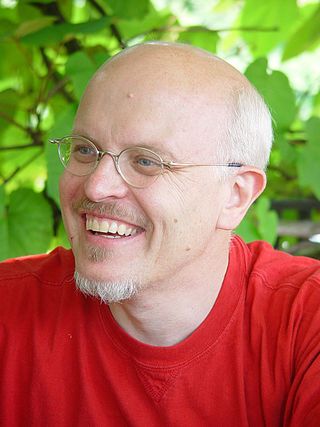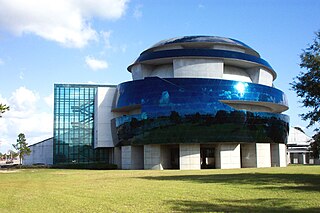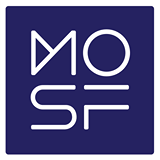Related Research Articles

The Museum of Science and Industry (MSI) is a science museum located in Chicago, Illinois, in Jackson Park, in the Hyde Park neighborhood between Lake Michigan and The University of Chicago. It is housed in the Palace of Fine Arts from the 1893 World's Columbian Exposition. Initially endowed by Julius Rosenwald, the Sears, Roebuck and Company president and philanthropist, it was supported by the Commercial Club of Chicago and opened in 1933 during the Century of Progress Exposition.

The Science and Industry Museum in Manchester, England, traces the development of science, technology and industry with emphasis on the city's achievements in these fields. The museum is part of the Science Museum Group, a non-departmental public body of the Department for Digital, Culture, Media and Sport, having merged with the National Science Museum in 2012.

The Franklin Institute is a science museum and the center of science education and research in Philadelphia, Pennsylvania. It is named after the American scientist and statesman Benjamin Franklin. It houses the Benjamin Franklin National Memorial. Founded in 1824, the Franklin Institute is one of the oldest centers of science education and development in the United States. Its chief astronomer is Derrick Pitts.

Judy Chicago is an American feminist artist, art educator, and writer known for her large collaborative art installation pieces about birth and creation images, which examine the role of women in history and culture. During the 1970s, Chicago founded the first feminist art program in the United States at California State University, Fresno which acted as a catalyst for feminist art and art education during the 1970s. Her inclusion in hundreds of publications in various areas of the world showcases her influence in the worldwide art community. Additionally, many of her books have been published in other countries, making her work more accessible to international readers. Chicago's work incorporates a variety of artistic skills, such as needlework, counterbalanced with skills such as welding and pyrotechnics. Chicago's most well known work is The Dinner Party, which is permanently installed in the Elizabeth A. Sackler Center for Feminist Art at the Brooklyn Museum. The Dinner Party celebrates the accomplishments of women throughout history and is widely regarded as the first epic feminist artwork. Other notable art projects by Chicago include International Honor Quilt, Birth Project, Powerplay, and The Holocaust Project. She is represented by Jessica Silverman gallery.

Jan Lorenc is a Polish-American designer and author. Born in Jaśliska, Poland in 1954, he immigrated to the United States at the age of 8. He formed Lorenc Design in 1978 in Chicago, and later moved it to Atlanta in 1981.

The Museum of Science & Industry (MOSI) is a non-profit science museum located in Tampa, Florida.
The MIT Museum, founded in 1971, is located at the Massachusetts Institute of Technology in Cambridge, Massachusetts. It hosts collections of holography, technology-related artworks, artificial intelligence, architecture, robotics, maritime history, and the history of MIT. Its holography collection of 1800 pieces is the largest in the world, though only a few selections from it are usually exhibited. As of 2023, works by the kinetic artist Arthur Ganson are the largest long-running displays. There is a regular program of temporary special exhibitions, often on the intersections of art and technology.

The Great Train Story is a 3,500-square-foot (330 m2) HO scale model railroad display located in the Transportation Zone of Chicago's Museum of Science and Industry. It explains the story of modern-day rail transportation in a 2,206-mile (3,550 km) journey from Seattle, Washington, through several plains states en route to Chicago, Illinois. The layout features 192 custom models of buildings and landmarks including the Willis Tower, Chicago Board of Trade Building, and Union Station in Chicago; and Seattle’s Space Needle, Experience Music Project and King Street Station. The landscape between the two cities includes several natural features such as the Cascade range, Rocky Mountains, waterfalls and forests. Man-made highlights include small towns, tunnels, truss arch and truss bridges, a lumber mill, farms, grain silos, a fruit packing house, a coal mine, and a steel mill.

Jeanne Gang is an American architect and the founder and leader of Studio Gang, an architecture and urban design practice with offices in Chicago, New York, and San Francisco. Gang was first widely recognized for the Aqua Tower, the tallest woman-designed building in the world at the time of its completion. Aqua has since been surpassed by the nearby St. Regis Chicago, also of her design. Surface has called Gang one of Chicago's most prominent architects of her generation, and her projects have been widely awarded.

June Claire Wayne was an American painter, printmaker, tapestry innovator, educator, and activist. She founded Tamarind Lithography Workshop (1960–1970), a then California-based nonprofit print shop dedicated to lithography.
Diana Thater is an American artist, curator, writer, and educator. She has been a pioneering creator of film, video, and installation art since the early 1990s. She lives and works in Los Angeles, California.

Michelle Kaufmann is an American architect and designer. In 2002, Kaufmann founded Michelle Kaufmann Designs, which designed and built single-family and multi-family green homes using prefabricated modular technology. The firm was closed in May 2009 and Kaufmann started a new design firm, Michelle Kaufmann Studio. Kaufmann is also a co-founder of Flux.io, a company developing collaborative design software for the building design and construction industry.
The Art of the Brick is a traveling exposition of sculptures made by Nathan Sawaya using Lego building bricks. It premiered in 2007 and as of 4 April 2022 continues to hold exhibitions around the world.

The Museum of Science Fiction (MOSF) is a 501c(3) nonprofit museum that originally had plans to be based in Washington, D.C. It was founded in the spring of 2013 by Greg Viggiano and a team of 22 volunteer professionals with a goal of becoming the world's first comprehensive science fiction museum.

Andrea Polli is an environmental artist and writer. Polli blends art and science to create widely varied media and technology artworks related to environmental issues. Her works are presented in various forms, she uses interactive websites, digital broadcasting, mobile applications, and performances, which allows her to reach a wider audience.
Olivia Marie Braida-Chiusano is an American botanical artist, author, and educator.
Flavia Sparacino is an American-based space maker and scientist. She is currently CEO/Founder of Sensing Places, a MIT Media Lab spinoff that specializes in immersive space design and technology.
Lovie Olivia is an American multidisciplinary visual artist. She uses the media of printmaking, painting, and installations to explore themes of gender, sexuality, race, class and power.

Behnaz Farahi is an Iranian-born American interdisciplinary designer and educator whose work melds architecture, fashion, interaction design, computational design, wearable technology and the human body. Her designs often explore the possibilities of human interaction with the environment and how technology can facilitate this interplay. Her work engages with the human body's relationship to its surroundings and how wearable technology can respond to, or be influenced by stimuli such as human emotions or environmental factors. Leveraging technology and art, Farahi's works are commentaries on power dynamics, society, and identity, frequently drawing inspiration from her cultural background and Western theories and practices, underpinned by theoretical concepts including socio-political feminist theory and anthropology.
Lee H. Skolnick is an architect and the Founding Partner and Design Principal of SKOLNICK Architecture + Design Partnership, a New York-based design firm specializing in both cultural/institutional and private residential projects.
References
- ↑ George, Doug. "Museum of Science and Industry scientist, and her tornado, star on CBS show 'Mission Unstoppable'". chicagotribune.com. Retrieved 2022-03-31.
- ↑ Hastings, Tara (2020-03-04). "Four-story tornado helps kids understand science". WISH-TV | Indianapolis News | Indiana Weather | Indiana Traffic. Retrieved 2022-03-31.
- 1 2 3 4 5 6 7 8 9 10 11 12 Publika, Liz (January 25, 2022). "Olivia Castellini on Being the Senior Exhibit Developer at the Museum of Industry & Science, Chicago". ARTpublika Magazine. Retrieved April 9, 2022.
- ↑ "Dr. Olivia Castellini". www.msichicago.org. Retrieved 2022-04-09.
- ↑ "About the Museum". www.msichicago.org. Retrieved 2022-04-09.
- ↑ "Science Storms exhibition overview". Museum of Science and Industry in Chicago.
- ↑ "Science Storms". Evidence Design.
- 1 2 "The Thrill of Science". Metropolis. Retrieved 2022-04-09.
- ↑ Berman, Shari, Olivia Castellini, Jim Cortina, and Rondi Davies. "Strategic Integration of Media in Exhibitions: Case Study of Science Storms". Informal Learning Review.
{{cite journal}}: CS1 maint: multiple names: authors list (link) - ↑ Interactive, Blue Oak (2016-07-13). "The 20 Most Influential Exhibit Designs this Century". segd.org. Retrieved 2022-04-09.